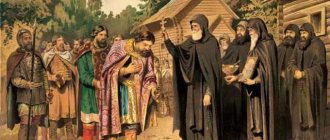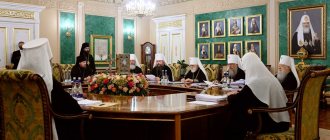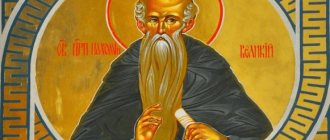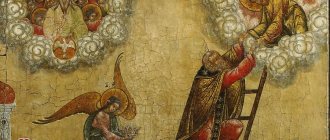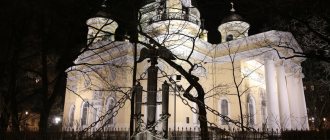New Kremlin
It is to Dmitry Ivanovich that we owe the fact that Moscow is still called “white stone” to this day. He inherited the Kremlin made of oak logs, built under Ivan Kalita, his great-grandfather. Over time, the Kremlin walls became dilapidated, and during the reign of Dmitry Ivanovich, the first stone Kremlin was built. Its towers were made of white stone, and the walls in the most likely places of assault were lined with stone. A ditch was dug from the Neglinnaya River to the Moscow River, which served as additional protection for the fortress. Dmitry Ivanovich's fortress turned out to be reliable. Twice – in 1368 and 1370 – it enabled Muscovites to withstand the siege of the Lithuanian prince Olgerd. After the Kremlin was taken by Khan Tokhtamysh in 1382, the fortifications were quickly restored.
Before the Battle of Kulikovo
The main event, thanks to which Dmitry Donskoy entered Russian history as the prince who began the fight against the Horde yoke, was the famous Battle of Kulikovo in 1380. It was by no means the first battle with the Horde in which Dmitry Ivanovich became the winner. Before the Battle of Kulikovo in 1378 there was also a battle at the Vozha River. Even earlier, the Russian regiments were defeated on the Pyana River by the Khan of the Blue Horde, Arapsha. However, Dmitry Ivanovich managed to take revenge on Vozha. Using intelligence data, he managed to block the ford along which the Tatar army was supposed to cross. The Tatar Murza Begich did not dare cross the river in sight of the Russian army and got stuck on the opposite bank. Then Dmitry Ivanovich withdrew his troops from the river, “giving” the bank to the Horde, but preparing to strike as soon as the enemy lost his vigilance. Begich fell into a trap and was defeated.
Portraits from historical chronicles
Prince Dmitry Donskoy, portrait from the “Tsar's Titular Book” of the 17th century
Prince Dmitry Donskoy, portrait from the collection “The Root of Russian Sovereigns”, 1672
Grand Duke Dmitry Ioannovich Khud. W. Tuck
Portrait of Dmitry IV Ivanovich Donskoy. Engraving from 1783.
Battle of Kulikovo
It is no coincidence that the battle on the Kulikovo Field is considered a turning point in Russian history, when Muscovites, Tver, Suzdal, Vladimir and residents of other principalities felt themselves to be a single people - Russians. Its significance was already understood by contemporaries, who dedicated two important literary works to the Battle of Kulikovo: “The Tale of the Massacre of Mamayev” and “Zadonshchina.” These texts are so full of symbols drawn from sacred history, metaphors and allegories that it is difficult to consider them serious sources, and experts to this day piece by piece reconstruct the course of the famous battle and argue about its place. However, there are several facts that speak of Dmitry Ivanovich’s undoubted military leadership talent. With the speed of maneuver and the correctly made decision to cross the Don, he forced Mamai to enter the battle on those conditions and at a time when it was convenient for the Russians. The outcome of the battle was predetermined by the use of an ambush regiment, the idea of which also belonged to Dmitry Ivanovich. However, it is difficult to understand the motives that prompted him to change into the armor of a simple warrior, and give his attire and weapons to another person, whom the Tatars considered a prince and tried to kill. Dmitry himself fought in the ranks of the Big Regiment at this time. The crowding and crush on the battlefield was so strong that Dmitry was found after the victory, covered with a tree trunk, which collapsed from the blows of the swords of the fighters. The prince was unconscious, but alive. This strange masquerade gives grounds for modern spiteful critics to accuse Dmitry Donskoy of almost cowardice, but it is worth imagining what a medieval hand-to-hand battle was like to understand: we are talking about anything but cowardice.
Orthodox Life
Orthodoxy and Modernity
The famous philosopher-priest Pavel Florensky wrote: “To understand Russia, one must understand the Lavra, and in order to delve into the Lavra, one must look with attentive eyes at its founder, recognized as a saint during his lifetime, “the wonderful old man, Saint Sergius.” A similar thought was expressed by the writer Evgeniy Poselyanin: “If Russia has a national hero who best expresses the spirit of Russia, then, of course, it is St. Sergius.” Indeed, there is probably no other saint whose life and deeds were so closely connected with the history of not only the Russian Church, but all of Russia.
Hegumen of the Russian Land - this is how St. Sergius is called. And this is not just an epithet. These words express the feeling of love of Orthodox Russian people for the Radonezh abbot and his monastery. Every person can see in St. Sergius a mentor and leader. The priest will see the example of a devout servant and inspired man of prayer, who was honored with the concelebration of the Angelic forces during the Liturgy. The monk is a role model in solitary life, prayer and obedience. Even as abbot, Abba Sergius continued to serve his brethren, considering himself the last in the monastery. Any Orthodox family will find in the life of the saint an example of mutual love and raising children. Reverends Cyril and Maria of Radonezh - the parents of the Reverend - instilled in their son faith and love for God. From them he received the desire for true Christian life and simplicity. Even a child will see in the youth Bartholomew - this is the name of the Reverend in the world - an ordinary boy, to whom not everything was easy. Only faith and trust in God's help helped him keep up with his peers.
Many books have been written about the life and feat of St. Sergius of Radonezh and the history of the monastery he founded. But today I would like to turn to the life of the Reverend, as told by artists.
We are all accustomed to iconographic images of the Radonezh abbot, but the image of his ascetic life has reached us not only in the form of an icon. The life of the Saint also inspired artists, who through their works wanted to express the inner spiritual world of the great saint. One of the most prolific authors in this field is Mikhail Nikolaevich Nesterov (1862-1942). Among his paintings there are many works on church themes. But the Abbot of Radonezh occupies a very special place in his work. Mikhail Nikolaevich himself admitted this. His greatest masterpiece is “The Vision of the Youth Bartholomew.”
This painting is not just a milestone in the work of the great Russian artist, it is a milestone in his life’s journey. Mikhail Nikolaevich once said: “It’s not me who will live. “The Youth Bartholomew” will live. Now, if thirty, fifty years after my death he still says something to people, that means he’s alive, and that means I’m alive too.”
The picture tells of a miracle when, through the prayer of the elder, book wisdom was revealed to the youth Bartholomew, and he began to read. It was hard for the young heart to endure the strict reproaches of the teacher and the ridicule of his peers, who saw that Bartholomew was not given book wisdom. But what saddened the boy much more was that he could not read the Word of the Lord himself. And so, after meeting with the holy elder, he received the fulfillment of what he fervently prayed for.
Let us take a closer look at the figure of the humble youth - the prayerful pose, reverence for the elder schema-monk, meekness and trust in God. The Reverend remained this way throughout his life. The same youth filled with humility appears before us in other works of M.N. Nesterov: “The Youth of St. Sergius”, “St. Sergius of Radonezh” and “The Works of St. Sergius”.
Here the already matured Sergius is addressed to us, having tasted the first difficulties of the hermit’s life. But it is not grief and fatigue that expresses his gaze, but the joy of being with God. Impenetrable forests became his home, wild animals became his closest friends. One day, a bear, weak from hunger, came to the saint’s cell, to which St. Sergius gave his crust of bread.
The next painting by Nesterov shows us St. Sergius in monastic garb. The gentle and calm gaze of the saint, addressed to the viewer and at the same time directed upward, to the sky, seems to call for him. The staff in his hand and the buildings visible in the distance tell us that Saint Sergius is already leading the brethren gathered around him. His feat became known, and many people turned to him for spiritual advice.
And here is the Reverend at work together with the brethren of the monastery. He did not want to stand out from others and always set an example of obedience and strictness of monastic life. When the brethren asked him to become abbot, he replied: “I wish to study better than to teach; It is better to obey than to command; but I am afraid of God's judgment; I don’t know what pleases God; the holy will of the Lord be done!”
Along with others, Abba Sergius performed monastic work, built wooden cells himself, carried and sawed logs, carried water, baked bread and cooked food, and sewed clothes. He always wore the same clothes, in any weather - hot or cold. He humbled his body, but his spirit grew more and more.
This is how Apollinary Mikhailovich Vasnetsov (1856-1933) imagined the Sergius monastery: a wooden temple, cells, monastic obediences. Perhaps one of the working monks is the Radonezh abbot himself?
M.N. Nesterov and A.M. Vasnetsov - the names of these Russian artists are known to everyone. But the work they started continues today. The life of St. Sergius inspires our contemporaries. A wonderful painting telling about the miracle of the resurrection of a dead boy was painted by Natalya Klimova.
A peasant takes his seriously ill son to the forest to Abbot Sergius, who lives there, and performs miracles through his prayers to God. But the boy dies... The picture conveys the very moment of the miracle - the elder’s hands raised in prayer, the peasant entering his cell with a coffin in his hands. The father, clouded with grief, has not yet seen his son, his thoughts are on something else, but in a moment the inconsolable grief will be replaced by joy.
This is the work of the artist Sergei Efoshkin “The Miracle of the Birds”. “Sergius, you pray for your students, and your prayer is heard. Look, see how many monks are gathering under your leadership!” — the Reverend once heard during prayer. After this, he saw an extraordinary light from the sky and many beautiful birds on the roofs and in the courtyard of the monastery. This picture conveys the miraculous revelation of God to Saint Sergius about the fate of the Trinity Monastery. The birds are all those who continue to gather under the arches of the Monk’s cell to follow his example of monastic feat.
But let's go back to the past again. The author of the famous “Military Council in Fili,” Alexey Danilovich Kivshenko (1851-1895), painted a picture of another military council. This is the advice of Grand Duke Dmitry with St. Sergius before the Battle of Kulikovo with the hordes of Khan Mamai. We see the humbly bowed head of the Grand Duke and the blessing hand of the Abbot of the Russian land...
“Go, don’t be afraid. God will help you,” the prince hears from the lips of the Reverend. The two armies have united with each other - the earthly army asks for help from the army who have dedicated themselves to serving God. The sword is in the hands of Prince Dmitry, the spiritual sword - the Cross of Christ - in the hands of St. Sergius. God is not in power, but in truth... The same plot is written by a contemporary author - priest Sergius Simakov.
Painting “Saints Sergius of Radonezh and Dmitry Donskoy” - The monk blesses the prince, sending two heroic monks Alexander-Peresvet and Andrei-Oslyabya to his army. It is not chain mail and shields that adorn the monks - it is monastic robes and firm faith in God.
The Monk Sergius reposed on September 25 (October 8, new style) 1392. His life path is from a humble youth to an elder, before whom princes bowed their heads. Abba Sergius addresses us through his life, through icons and, as we have seen, through paintings. If he is the Abbot of the Russian land, then we are all his faithful children, listening to his words. The life of St. Sergius is the life of a person in God. And strangely enough, the ascetic who went into the deep forests turned out to be so close both to those who lived at the same time as him, and to us, who live seven centuries after him. Why? The answer is very simple: the closer a person is to God, the closer he is to others - to those who need his help and living example.
Priest Vasily Kutsenko
